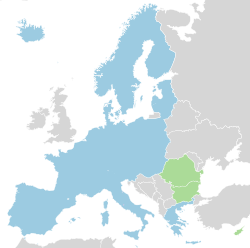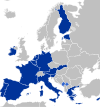Schengen Agreement
 Schengen Area
Future members
|
|
| Description | Free travel area |
|---|---|
| Established | 1995 |
| Members | |
| Policy of | European Union |
| Area | 4,312,099 km2 |
The Schengen Agreement is a treaty signed on 14 June 1985 near the town of Schengen in Luxembourg, between five of the ten member states of the European Economic Community. It was supplemented by the Convention implementing the Schengen Agreement 5 years later. Together these treaties created Europe's borderless Schengen Area, which operates very much like a single state for international travel with border controls for travellers travelling in and out of the area, but with no internal border controls.
The Schengen Agreements and the rules adopted under them were entirely separate from the EU structures until the 1997 Amsterdam Treaty, which incorporated them into the mainstream of European Union law. The borderless zone created by the Schengen Agreements, the Schengen Area, currently consists of 25 European countries, covering a population of over 400 million people and an area of 4,312,099 square kilometers (1,664,911 sq mi).[1]
Contents |
[edit] History


Before 1914, it was possible to travel from Paris to Saint Petersburg without a passport.[2] When the First World War came to an end, the practice of issuing passports and performing routine passport controls at national frontiers remained and became the norm in Europe until the implementation of the Schengen Area in 1995.
There were of course several exceptions. After the secession of the Irish Free State from the United Kingdom in 1922, both countries passed laws that treated the other country as part of its own territory for immigration purposes. This Common Travel Area still exists today, albeit in a much more limited fashion.
In 1944, the governments-in-exile of Belgium, the Netherlands and Luxembourg (Benelux) signed an agreement to eliminate border controls between themselves; this agreement was put into force in 1948. Similarly, the Nordic Passport Union was created in 1952 to permit free travel amongst the Nordic countries of Denmark, Finland, Iceland, Norway, and Sweden and some of their associated territories. Both of these areas have largely been subsumed within the Schengen Area.
The Schengen Agreement was signed on 14 June 1985 on the river-boat Princess Marie-Astrid in the middle of the river Moselle where the territories of France, Germany and Luxembourg meet. The original signatories were Belgium, France, Luxembourg, the Netherlands, and West Germany.[3] As Belgium, the Netherlands and Luxembourg formed the "borderless Benelux" (s.a.), the agreement was in a way signed at the border triangle of all original signatories. It was created independently of the European Union, in part owing to the lack of consensus amongst EU members over whether or not the EU had the competence to abolish border controls,[4] and in part because those ready to implement the idea did not wish to wait for others (back then there was no Enhanced co-operation mechanism). The Agreement initially only provided for the replacement of passport checks with visual surveillance of private vehicles, which would be able to cross borders without stopping albeit at reduced speed.
| European Union |
 This article is part of the series: |
|
Policies and issues
|
|
|
In 1990, before the Schengen Agreement had been implemented, the same five states signed a Convention implementing the Schengen Agreement. It was this Convention that created the Schengen Area through the complete abolition of border controls between Schengen states, common rules on visas, and police and judicial cooperation.
The Schengen Agreement along with its implementing Convention was implemented in 1995 only for some signatories, but just over two years later during the Amsterdam Intergovernmental Conference, all European Union member states except the United Kingdom and Ireland, and two non-member states Norway and Iceland (part of the Nordic Passport Union along with EU members Denmark, Finland, and Sweden) had signed the Schengen Agreement. It was during those negotiations, which led to Amsterdam Treaty, that the incorporation of the so-called Schengen-Acquis[5] into the main body of European Union law was agreed along with opt-outs for Ireland and the United Kingdom, which were to remain outside of the Schengen Area.
Now that the Schengen Agreement is part of the acquis communautaire, the Agreement has lost the status of a treaty, which could only be amended according to its terms; instead, its amendments are made according to that legislative procedure of the EU that covers the rules to be amended as defined in the EU treaties.[6] Ratification by the former agreement signatory states is not required for altering or repealing some or all of the former Schengen-Acquis.[7] Legal acts setting out the conditions for entry into the Schengen Area are now enacted by majority vote in the legislative bodies of the European Union. New EU member states do not sign the Schengen Agreement as such; instead, they are bound to implement the Schengen rules as part of the pre-existing body of EU law, which every new entrant is required to accept.
This led to the result that the Schengen States that are not EU members have few formally binding options to influence the shaping and evolution of the Schengen rules; their options are effectively reduced to agreeing with whatever is presented before them, or withdrawing from the agreement. Of course, similarly to the European Economic Area practice, consultations with the affected countries are conducted informally, prior to the adoption of particular new legislation.
In 2006 the directive on the right to move freely (2004/38/EC) was implemented, meaning that passportless travel is allowed in the entire European Union, if having a national identity card from an EU country. For some a passport is necessary anyway, since not all countries issue such cards for their citizens, and because Sweden requires a passport when travelling from that country to EU countries outside Schengen.
[edit] See also
- Central America-4 Border Control Agreement
- Enhanced co-operation
- European Union law
- Four Freedoms (European Union)
- Prüm Convention
- Schengen Area
- Schengen Information System
[edit] References
- ^ European Commission. "Schengen area". Europa web portal. http://ec.europa.eu/home-affairs/policies/borders/borders_schengen_en.htm. Retrieved 13 January 2011.
- ^ Hawley, Charles (2 August 2004). "Hot topic in Germany: aggression in World War I". The Christian Science Monitor. http://www.csmonitor.com/2004/0802/p06s03-woeu.html. Retrieved 12 February 2011.
- ^ Fortress Europe, http://www.bbc.co.uk/worldservice/theneweurope/wk22.htm
- ^ Craig, Paul; de Burca, Grainne (2003). EU Law: Text, Cases and Materials (3rd ed.). Oxford: Oxford University Press. p. 751. ISBN 0-19-924943-1.
- ^ The complete acquis, including the fundamental Agreement and Convention and some subsequent acts and instruments brought about meanwhile in its legal framework, had been published here: "Official Journal of the European Communities - The Schengen Acquis" (in English). 2000-09-22. http://eur-lex.europa.eu/LexUriServ/site/en/oj/2000/l_239/l_23920000922en00010473.pdf. Retrieved 2007-11-25..
- ^ At first the Council of the European Union, later the European Parliament and the Council of the European Union in the codecision procedure, took the place of the Executive Committee that had been created under the agreement; Council Decision of 22 December 2004 providing for certain areas covered by Title IV of Part Three of the Treaty establishing the European Community to be governed by the procedure laid down in Article 251 of that Treaty
- ^ Example: By article 39 subsection 1 of the Schengen Borders Code, Articles 2 to 8 of the Schengen Agreement had been repealed - "Regulation (EC) No 562/2006 of the European Parliament and of the Council of 15 March 2006 establishing a Community Code on the rules governing the movement of persons across borders (Schengen Borders Code)" (in English). 2006-04-13. http://eur-lex.europa.eu/LexUriServ/site/en/oj/2006/l_105/l_10520060413en00010032.pdf. Retrieved 2007-11-25..
[edit] External links
| Wikimedia Commons has media related to: Schengen Agreement |
- Agreement between the Governments of the States of the Benelux Economic Union, the Federal Republic of Germany and the French Republic on the gradual abolition of checks at their common borders - The Schengen Agreement
- Convention implementing the Schengen Agreement of 14 June 1985 between the Governments of the States of the Benelux Economic Union, the Federal Republic of Germany and the French Republic on the gradual abolition of checks at their common borders - Convention implementing the Schengen Agreement
- Schengen – eurotopics
- The Schengen area – European NAvigator
- The Schengen Acquis – EUR-Lex
|
||||||||||||||||||||||||||||||||||||||||||
|
||||||||||||||||||||||||||







